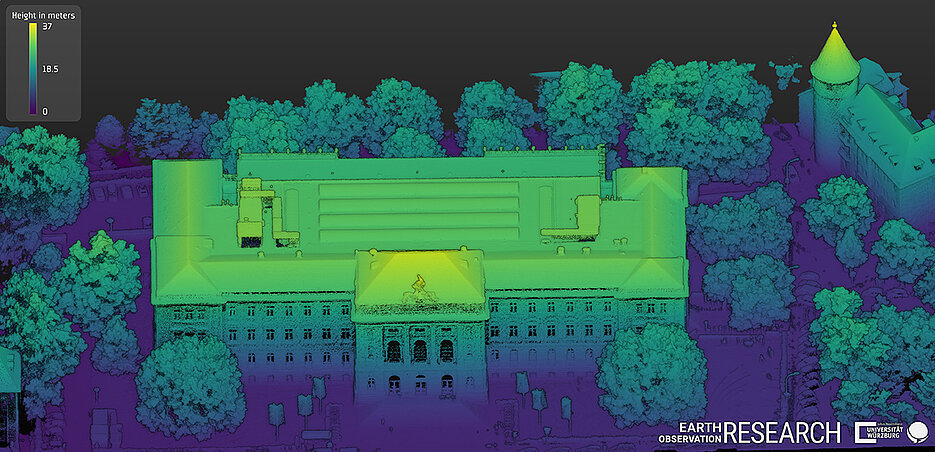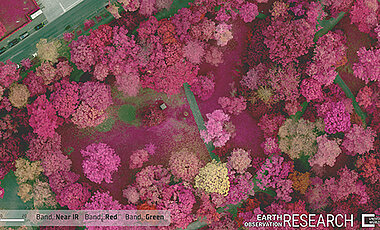Drones Collect Environmental Data
01/20/2023Mapping trees, finding heat islands: Research drones offer many new options for small-scale observation of the environment.

Earth observation, also known as remote sensing, provides highly relevant information about the state and change of our planet every day via satellite data worldwide. The data can be used, for example, to gather information about heat islands in cities, droughts or the condition of forests.
Earth observation is currently opening up additional data sources: With sensors installed on commercially available drones, it is obtaining further detailed environmental information - and at a spatial resolution so high that it cannot be achieved with satellite data.
"The very high resolutions in the centimetre range open up new areas of application and research questions," says scientist Dr Mirjana Bevanda from the Earth Observation Research Hub at Julius-Maximilians-Universität Würzburg (JMU), a merger of the JMU Chairs of Remote Sensing and Global Urbanisation and Remote Sensing. "We are thus gaining highly relevant information for urban research, ecology and nature conservation."
Mapping heat islands and urban trees
For a feasibility study, Mirjana Bevanda, together with Antonio Castañeda and other colleagues, imaged the Neue Universität on Sanderring and parts of Würzburg's Ringpark with drones in 2022. Lidar, a form of three-dimensional laser scanning, as well as thermal and multispectral sensors were used. The latter capture five to ten wavelengths of light and thus significantly more than a simple photo camera.
The aim of the study is to explore what added value the data obtained can offer for research in urban spaces, for example to record and analyse urban structure or to map urban trees or heat islands.
"We can use this to contribute to reducing the heat island effect with targeted countermeasures, for example," explains Professor Hannes Taubenböck. This effect occurs when cities with their many stones and asphalt surfaces heat up more than the surrounding countryside in summer. This not only puts a strain on people in the city, but also on animals and plants.
Drones also open up new options for mapping urban trees. "We could describe each tree individually, including its vertical structure, and draw conclusions about its vitality," says Professor Tobias Ullmann.
Active in many study areas
The team from JMU's Earth Observation Research Hub is also active with drones in Canada and other study areas, documenting their changes over time. With partners, for example from biology, it also takes a look at ecological aspects. For example, environmental data from the JMU Forest in the Steigerwald, from calcareous grasslands in Lower Franconia or from high alpine structures on the Zugspitze are processed.
"Data acquisition with drones is very time-consuming, among other things because of the necessary approval procedures. But the data obtained and especially its level of detail is very relevant for many research questions," says Tobias Ullmann.
The Würzburg studies focus on methodological approaches to make data acquisition and its processing more efficient. In addition, the environmental information relevant to the individual research questions is to be identified. "In the long term, we want to gain new insights for Earth observation from this work, which in turn can be transferred to space-based systems," says Mirjana Bevanda.
Contacts also exist with JMU Informatics. "We do field work and evaluate the data obtained for environmental research. But developing new sensors and systems is not our expertise. Here we see great potential in cooperation with various computer science working groups," says Hannes Taubenböck.
Use in the EAGLE Master's programme
The studies on earth observation with research drones – the experts speak of Unoccupied Aerial Systems (UAS) – flow into the teaching in the international Würzburg Master's programme EAGLE (Applied Earth Observation and Geoanalysis of the Living Environment). After all, the future generation of researchers also needs to be trained in this field.
Antonio Castañeda, an EAGLE alumnus from Colombia, is one of those involved. He is currently a PhD student at the Earth Observation Research Hub, focusing on UAS-based remote sensing research.
"Integrating UAS into teaching gives students completely new experiences in mission planning, sensor geometry, data management and analysis," says Tobias Ullmann. They are thus confronted with new challenges that usually do not exist in space-based Earth observation.
Contact
Dr. Mirjana Bevanda, Prof. Dr. Tobias Ullmann, Prof. Dr. Hannes Taubenböck, Earth Observation Research Hub, University of Würzburg, mirjana.bevanda@uni-wuerzburg.de
Web links
Earth Observation Research Hub Würzburg www.earth-observation.org
Master's programme EAGLE (Applied Earth Observation and Geoanalysis of the Living Environment) www.eagle-science.org








